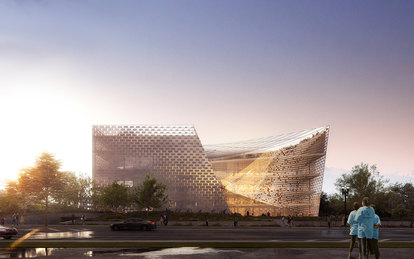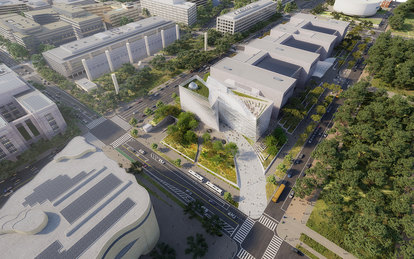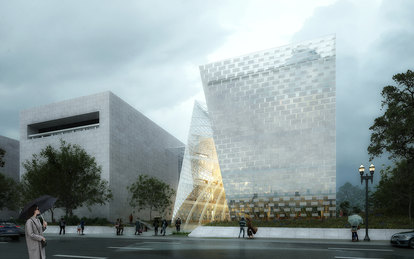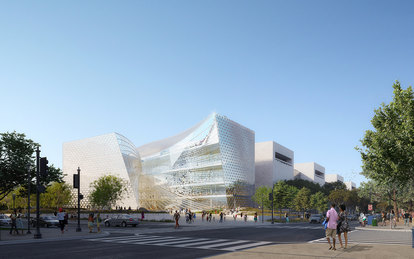Bezos Learning Center Competition Concept Design, National Air and Space Museum
Inspired by the cosmic forces of star-creating nebulae, a concept design for a new educational center at the National Air and Space Museum ignites imagination and wonder in young learners.
Client
Smithsonian Institution
Location
Washington, D.C.
Markets/Services
Cultural, Federal Cultural, Museums
Size
60,000 SF
Celebrating the history and science of aviation and space exploration, the National Air and Space Museum (NASM) is one of the most popular of the many Smithsonian Institution museums in Washington, D.C. In 2021, Amazon founder Jeff Bezos announced a $200-million donation to fund a new education center at the museum’s flagship location on the National Mall. The Smithsonian Institution reviewed over 20 proposals from national and international architects before inviting SmithGroup and four other design firms to participate in a design competition for the Bezos Learning Center (BLC), with several stated goals that emphasize a thoughtful connection to the museum’s history, mission and location, and an inspiring, flexible environment that celebrates student work.
SmithGroup’s competition design speaks to the history of the universe, rooted in the metaphor of the nebula—where future stars are born and, at the Bezos Learning Center, where the future generation of scientists are nurtured. As a new eastern module of the NASM, the concept would complement the materiality and scale of the existing museum and is bisected with a fritted glass portal that creates a sense of motion, as if in a state of active creation.
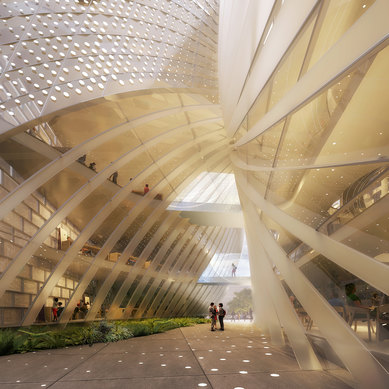
A Celestial Promenade would draw visitors toward its center, a nexus of concentrated energy where students imagine, learn and create.
Contextual considerations were a key priority of the proposed concept, given its prominent location on the National Mall. The selected design of the new Bezos Learning Center will replace the now demolished restaurant at the east end of the National Air and Space Museum, and SmithGroup’s proposed design concept would establish the addition as a fifth bay that is sympathetic to the museum’s original massing. In reference to the museum’s limestone panels, the concept would be clad in a thin stone veneer laminated within a glass curtainwall, a natural translucent beacon that seems to glow when illuminated from within.
The design concept would create a dynamic new interface with the National Mall, relocating a loading dock and parking ramps to make way for the accessible and pedestrian-friendly Celestial Promenade. This immersive human-scaled experience would guide visitors from the northeast and southwest corners of the site, along an interpretive walk through time. The landscape also has a celestial reference, manipulated into waves that interact with the sun to create moving shadow. The promenade would lead to the main entrances of both the future Bezos Learning Center and a new, more conspicuous NASM restaurant, a vital revenue generator for the Smithsonian.
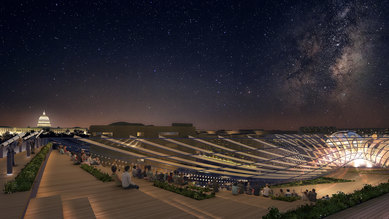
While respecting the existing NASM roofline and viewshed up and down the Mall, the proposed design makes a grand gesture toward the sky, creating an overall effect that is at once cosmic and timeless.
The entrance sweeps visitors into the heart of the nebula, a curvaceous light-filled atrium that ignites curiosity with its views into active educational spaces and sculptural details that seems to swirl and envelop its guests on a celestial journey. To develop the instructional areas of the competition concept, SmithGroup’s integrated team collaborated with scientists and educators during the competition, holding charettes and design crits with cross-disciplinary partners including Dr. Derrick Pitts, Lead Astronomer at the Franklin Institute.
The design concept incorporates a variety of learning, collaboration and maker spaces that are readily adaptable to different uses; a visual realization lab and outdoor classroom for project demonstrations; informal niches for dreaming and reflecting; and a rooftop observatory and astronomy terrace that serves as a one-of-a-kind educational and events venue. Together, SmithGroup’s design concept is a wondrous environment that would speak to the mission of the Bezos Learning Center, empowering young learners to imagine the possibilities of our future.
